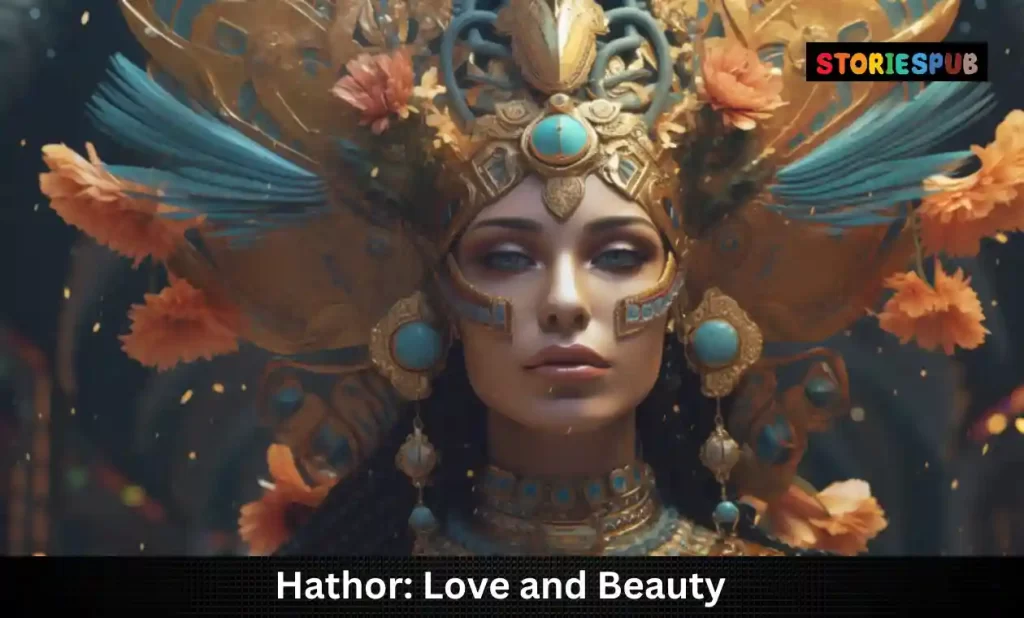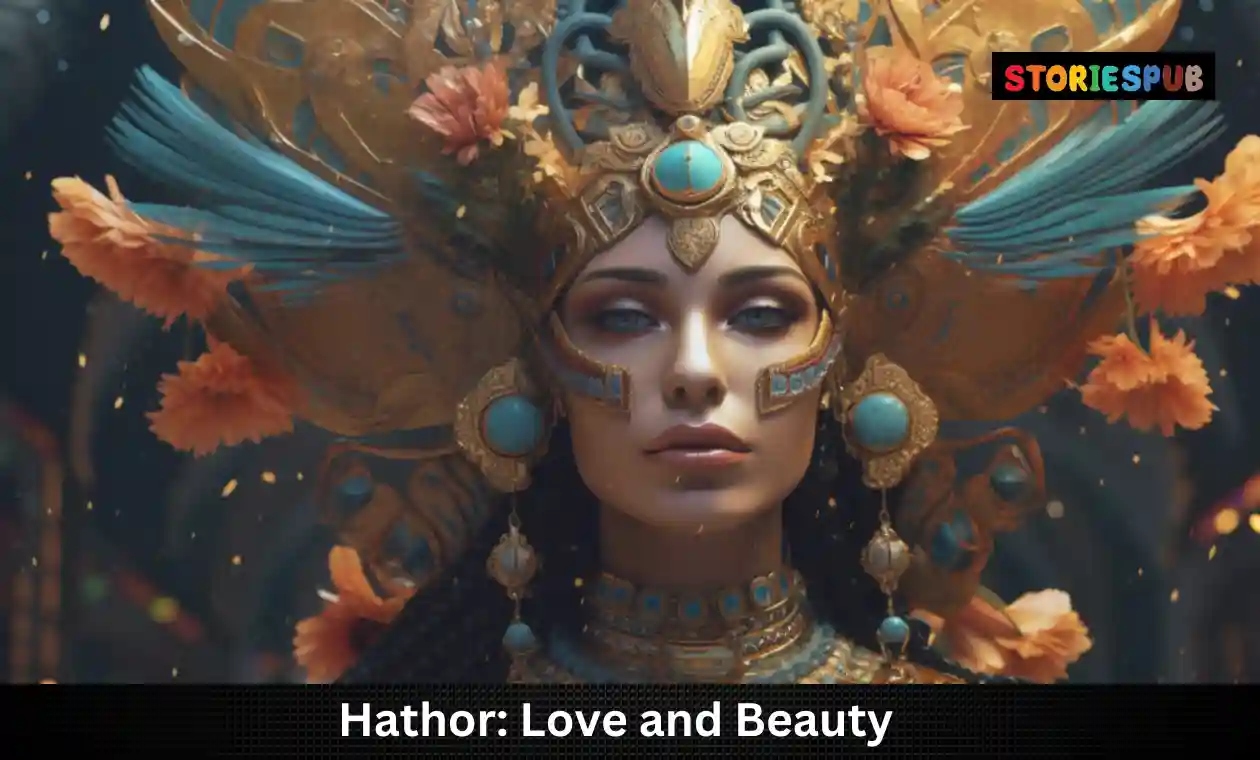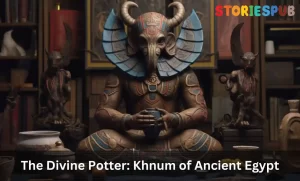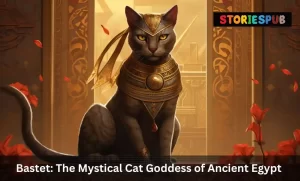Hathor – The goddess of love, beauty, and music

Introduction
Among the many gods and goddesses that populated the pantheon of Ancient Egypt, Hathor stands out as one of the most beloved. Known as the goddess of love, beauty, and music, Hathor played a central role in Egyptian mythology and religious practice.
Brief overview of Hathor
Hathor was often depicted as a cow-headed deity or a woman with cow’s horns and ears. She was associated with motherhood, fertility, and femininity. Her name means “House of Horus,” reflecting her early symbolism as the mother of Horus, the god of kingship.
Importance of Hathor in Egyptian mythology
Hathor was widely worshipped throughout ancient Egypt from pre-dynastic times to the Roman era. She played a significant role in both state-sponsored religion and popular beliefs. Hathor was closely associated with many other gods and goddesses in Egyptian mythology.
She was believed to be the wife or consort of several major deities including Horus, Ra, and Osiris. Her close associations with these powerful gods gave her an elevated status among other lesser-known deities.
In addition to her associations with fertility and motherhood, Hathor also held sway over matters related to music, dance, joy, and pleasure. Her worship took on many forms throughout history but always emphasized her nurturing aspects alongside these more sensual qualities.
Purpose of the Story
The story of Hathor serves several purposes within Egyptian mythology. For one thing, it provided an explanation for natural phenomena like fertility cycles and seasonal changes.
It also served to reinforce social norms by promoting virtues like love, beauty, music-making among other things. Myths about Hathor often functioned as an expression of hope and a means of coping with life’s uncertainties.
In times of trouble, her followers would turn to her for guidance, protection, and comfort. As we explore Hathor’s story, we will see how these different elements came together to create a rich tapestry of myth and legend that has withstood the test of time.
The Birth of Hathor
Hathor is one of the most significant goddesses in Egyptian mythology, and her birth story is as fascinating as her role in the ancient culture. According to creation myths, Hathor was born from the forehead of Ra, the sun god. The myth says that Ra was at war with his enemies and had grown tired and weak.
He looked to his eye for help, which transformed into a powerful goddess known as Sekhmet to defeat his enemies. However, Sekhmet became too destructive, and Ra feared she would destroy everything on earth.
So, he tricked her by pouring red-colored beer on the ground to make it look like blood. When Sekhmet drank it all up, she became too intoxicated to continue her rampage.
Ra then needed a way to calm down Sekhmet’s rage permanently. He turned to Thoth, god of wisdom and magic, who suggested that he create another goddess whose sole purpose would be to bring joy and happiness: thus Hathor was born.
The creation myth
Ra took his eye back into himself and from that moment on no longer had an eye; instead he had two eyes which were called “the Eyes of Ra”. The Eye of Ra represented power both destructive (Sekhmet) and creative (Hathor).
It was considered a symbol of protection for gods but also dangerous when they were angry or uncontrolled. The myth explains how Egyptians believed that gods controlled every aspect of nature including human destiny through their power over natural elements such as sky (Nut), earth (Geb), water (Tefnut) etc., so when Hathor was created, she represented not only joy but also fertility because she was associated with cows – animals traditionally seen as symbols for fertility.
The role of Ra and Nut in her birth
Ra’s involvement in Hathor’s creation was significant because he played a crucial role in creating the goddess. As the creator god, Ra had the power to bring forth life, and his determination to create Hathor ensured that she would be a significant and powerful figure in Egyptian mythology. Nut, on the other hand, represented both the sky and motherhood.
She was also considered as a protector of Ra and all deities. When Hathor was born from Ra’s forehead, Nut became her mother figure and took care of her like any mother would.
Symbolism behind her birth
In ancient Egyptian culture, Hathor’s birth symbolized several important concepts. Firstly, it represented rebirth and renewal since she emerged from Ra’s forehead after Sekhmet had destroyed everything.
Her creation also represented balance between order (Ra) and chaos (Sekhmet), which were two essential aspects of Egyptian mythology. Furthermore, Hathor’s birth symbolized femininity as she was created by male gods: Ra created her from his forehead while Thoth assisted in her birth.
Her association with cows also made her an important symbol of fertility that signified renewal in nature. Overall, Hathor’s birth story is full of symbolism that reflects various ancient Egyptian beliefs about life, death and rebirth – all themes that were central to their understanding of the world around them.
Hathor as the Goddess of Love and Beauty
Relationship with other gods and goddesses
In Egyptian mythology, Hathor was one of the most beloved goddesses. She was so significant that many other gods and goddesses were often associated with her. She was primarily linked to Ra, the sun god and Horus, the sky god.
Egyptian mythology has a vast pantheon of deities, including male and female gods, who had various roles in the universe. However, Hathor stood out as she represented love, beauty, motherhood, fertility and joy.
As the goddess of love and beauty, she had a deep connection with other goddesses such as Isis- who embodied motherhood while Hathor represented fertility- Bastet- who stood for pleasure while Hathor symbolized beauty-, Nut- who represented marriage while Hathor embodied love-. The relationship between these goddesses further highlights how important she was in ancient Egypt’s religion.
Her role in love and fertility rituals
As mentioned earlier, Hathor was known for fertility; thus her worshipers prayed to her for successful pregnancies. In addition to this role in childbirth rituals,, hapless women also prayed to her during their menstrual cycles because they believed that she would protect them from harm
Furthermore, since she represented love, couples also invoked her before getting married or bonding intimately. They believed that invoking the power of Hathor would help them create a successful union or even conceive children.
Depictions in art and sculpture
Hathor is recognizable by several physical attributes such as cow horns on her head,hair falling beneath them,having two separate ears (instead of joined),and holding onto a sistrum – an ancient musical instrument used during their celebrations.Her appearance helped distinguish her from other female deities. Her image is etched on numerous ancient temples, papyrus and tombs. In these depictions, she is always shown in her most glorious form -a feminine figure with a large bosom, beautiful eyes, and a gentle smile.
She also wears an Egyptian headdress and carries a sistrum in one hand while the other is held out to welcome all who seek her help. Hathor was a vital goddess of love and beauty in the ancient Egyptian religion.
Her role in promoting fertility, happiness and love made her an essential deity during childbirth and marriage rituals.Her representation was always marked by cow horns on her head which differentiated her from other gods. Egyptians considered Hathor as one of their most important deities due to the immense impact she had on their daily lives.Their deep devotion to her led to many temples being erected in her honor.
Hathor as the Goddess of Music
The Power of Sound and Music in Ancient Egypt
Sound and music played a vital role in ancient Egyptian life, culture, and religion. Music was believed to have the power to connect people with the gods.
The Egyptians believed that music could help them communicate with their gods better and hence would play music during religious ceremonies. Instruments such as harps, flutes, cymbals, trumpets, and drums were used in temples for ritual purposes.
Hathor’s Role in Music
As the Goddess of Love, Beauty, and Music, Hathor was an important figure in ancient Egyptian mythology. She was often depicted holding a sistrum or menat – musical instruments that were associated with her cult. Hathor was also believed to be the patroness of musicians who would invoke her during performances for blessing on their artistry.
The Role of Musicians in Society
Music played an important part in entertainment as well as religious rituals of ancient Egypt. Musicians were highly respected individuals who performed at various occasions like weddings or funerals and also served as entertainment for Pharaohs at their courts. They were considered to be skilled professionals who also had knowledge about astronomy and medicine.
Musicians had a significant place in society as they provided an escape from everyday life through their performances. They were respected for their abilities to create beautiful music that had healing powers too.
Depictions of Hathor in Art & Sculpture
Hathor is often depicted playing musical instruments such as the sistrum or menat. These depictions can be found on temple walls, tomb paintings, statues along with many other places throughout Ancient Egypt. In sculpture form, Hathoric images are shown wearing sacred regalia such as cow horns or cow ears symbolizing her divine nature.
She is often depicted with a gentle and nurturing expression, which matches her role as the goddess of love and beauty. Her image is also used in many amulets, which were believed to provide the wearer with protection and good fortune.
Conclusion
Music played an essential role in Ancient Egyptian society, with Hathor as their Goddess of Music. Musicians were highly respected members of society who played an important role in cultural events and religious ceremonies.
Hathor’s music represented her cultural importance to Ancient Egyptians, which was reflected in art and sculptures that paid homage to her. The power of music has been recognized since ancient times, and its impact is still evident today.
It continues to be a significant art form all over the world for entertainment as well as therapy. The unique connection between music and spirituality creates a powerful dynamic that transcends time.
The Legend of the Eye of Ra
The Eye of Ra was a powerful symbol in ancient Egyptian mythology representing the sun god’s power and wrath. The legend behind the Eye of Ra tells the story of how Ra sent his eye out to punish humanity for their disobedience.
The eye took the form of Hathor, transforming into a fierce lioness who rampaged across Egypt, slaughtering humans wherever she went. As Hathor continued her rampage, she eventually realized the error in her ways and sought to return to her true form.
She allowed herself to be lured back to Ra’s palace with offerings of beer and pomegranates. Once there, she transformed back into her original form and was welcomed back by Ra.
The Story Behind the Eye of Ra
The legend behind the Eye of Ra is closely tied to Egyptian creation mythology. According to this mythos, at the dawn of time, Ra created himself from nothingness and then created Shu (air) and Tefnut (moisture). These two then gave birth to Geb (earth) and Nut (sky), who had four children – Osiris, Isis, Set and Nephthys.
One day, while ruling over his kingdom on earth as pharaoh-god, Ra heard rumors that humanity was plotting against him. Fearing for his power and safety, he decided to send his eye out as a punishment for their disobedience.
Hathor’s Involvement with The Eye
In one version of this mythos, Hathor is said to be an aspect or manifestation of the Eye herself. As such, when she went on her rampage across Egypt it was seen as a direct result of human disobedience towards their god-king.
In other versions however Hathor is depicted as being separate from the Eye but playing an important role in its eventual return to Ra’s palace. This version of the story often portrays Hathor as a wise and insightful goddess, who saw the error in her ways and sought to make amends.
The Significance to Egyptian Mythology
The Eye of Ra was an important symbol in Egyptian mythology representing both the sun god’s power and his wrath. As such, it played a central role in many religious rituals, including those concerning fertility and protection.
In addition to its religious significance, the legend of the Eye of Ra also served as a warning to those who would dare disobey their god-king. It was a reminder that even the gods themselves could be wrathful if they felt threatened or disrespected.
Overall, the story behind the Eye of Ra is one that is rich with symbolism and meaning for ancient Egyptians. It speaks to their beliefs about power, authority, and divine retribution – ideas that were central to their worldview and way of life.
The Cults Of Hathor Throughout History
Widespread Worship Throughout Ancient Egypt
Hathor was one of the most popular and widely worshipped deities in ancient Egypt. Her cults were found in all corners of the country, with temples dedicated to her in cities such as Dendera, Edfu, and Thebes. The ancient Egyptians considered her a motherly figure who provided protection, guidance, and joy.
She was associated with femininity and fertility, making her a popular choice among women hoping to conceive. One of the most important centers of Hathoric worship was the temple at Dendera.
It was believed that this temple was built on the spot where Hathor was born, making it a sacred site for her devotees. The temple contained numerous shrines dedicated to different aspects of Hathor’s personality, including her role as a goddess of music and dance.
In addition to temples dedicated solely to Hathor, she also shared space with other deities in larger temples. For example, at the Karnak Temple Complex in Thebes, she had a shrine within the larger temple complex that housed multiple gods and goddesses.
The widespread worship of Hathor throughout ancient Egypt is evidence of how important she was to Egyptian society. Her influence went beyond religion; she was also an economic force due to the offerings made at her temples which included goods as well as currency.
Hathoric Cults Outside Egypt
Hathoric cults spread beyond Egypt’s borders during her time as a prominent deity in Egyptian mythology. Her popularity extended into neighboring regions where Egyptian influence had spread such as Nubia and Sudan. In Nubia specifically (modern-day southern Egypt and northern Sudan), Hathor was worshipped under the name “Hwt-Hr,” which translates to “Mansion of Horus.” This name reflects her association with the sky god Horus, who she is sometimes depicted with in Egyptian mythology.
Hathor’s influence also spread beyond regions that were directly under Egyptian rule. In ancient Cyprus, for instance, there are remains of a temple dedicated to Hathor that date back to around 600 BCE.
Archaeologists believe that this temple was built by settlers from Egypt who brought their culture and religious practices with them. Overall, Hathoric cults outside of Egypt were not as numerous as those inside Egypt but still served as evidence of the widespread cultural impact of ancient Egyptian society.
Modern-day Worshipers
While the era of ancient Egyptian religion has long since passed, there is still a small but dedicated group of modern-day worshipers who continue to honor Hathor. These individuals are often drawn to her because they see her as a symbol of feminine power and grace. In modern-day worship, Hathor is often associated with self-care practices such as meditation and yoga due to her connection to beauty and relaxation.
There are also communities online that discuss different aspects of tracing one’s lineage back to Egypt or other African countries in an attempt to reclaim their heritage. Despite being less visible today than she was in ancient times, the continued worship of Hathor serves as a reminder that her legacy lives on through those who still find value in her teachings and symbolism.
Conclusion
Throughout ancient Egyptian history, Hathor played a crucial role in the lives of the people. Her influence extended far beyond her roles as the goddess of love, beauty, and music.
She was also associated with motherhood, childbirth, and fertility. Hathor was worshiped by people from all walks of life, from peasants to pharaohs, as evidenced by the numerous temples dedicated to her throughout Egypt.
The importance of Hathor can be seen in various aspects of Egyptian culture. For example, dance was an essential part of worshiping Hathor as it was believed that dancing would attract her attention and bring blessings upon the worshipers.
Likewise, music played a significant role in Egyptian society and was often incorporated into rituals and festivals dedicated to Hathor. Hathor’s image can be found in many forms of art from ancient Egypt including sculptures and paintings.
Her portrayal often depicted her with cow ears or horns symbolizing her association with fertility and abundance. Today, many people still revere Hathor as a powerful goddess embodying love, beauty, fertility, creativity, and joy.
Modern practitioners of various spiritual traditions continue to honor this ancient deity through different rituals such as meditation or offerings. Hathor continues to inspire awe among modern-day scholars and enthusiasts alike while remaining one of the most revered gods in Egyptian mythology.
The goddess’s enduring impact on ancient Egyptian culture is remarkable given that it has been over two thousand years since her worship first began. It is clear that Hathor will remain an important figure for generations to come as she represents timeless values that are still relevant today such as love for ourselves and each other regardless of our differences or backgrounds; beauty both inner and outer; music which soothes our souls; creativity which allows us to express ourselves freely without judgment; joy which uplifts us even during difficult times; abundance which encourages us to be open-minded towards what life has to offer.
Hey kids, how much did you like Hathor – The goddess of love, beauty, and music ? Please share your view in the comment box. Also, please share this story with your friends on social media so they can also enjoy it, and for more such Egyptian Mythology, please bookmark storiespub.com.
Related Post :
Hathor FAQ
What were some of Hathor's responsibilities and areas of influence?
Hathor was associated with love, beauty, music, fertility, and motherhood. She was also believed to have the power to protect and heal.
How was Hathor worshiped in ancient Egypt?
Hathor was worshiped through prayers, offerings, and rituals in temples dedicated to her. The most important cult center for Hathor was the city of Dendera, where she was believed to have a special relationship with the pharaoh.
How did Hathor's image and symbolism evolve over time?
Hathor's image and symbolism evolved from that of a local cow deity to a powerful goddess associated with love, beauty, and music. Her image and symbols were often used in architecture, art, and jewelry.
What is the connection between Hathor and music?
Hathor was believed to be the patron goddess of music and dance. She was often associated with the sistrum, a musical instrument used in ancient Egyptian ceremonies.
How was Hathor related to other Egyptian gods and goddesses?
Hathor was often linked with other gods and goddesses, such as Ra, the sun god, and Horus, the god of the sky. She was also associated with the goddess Isis, who was believed to have motherly qualities.
What were some of the symbols associated with Hathor?
Symbols associated with Hathor include the cow, the sistrum, the sun disk, the ankh, an ancient Egyptian symbol of life, and the was scepter, a symbol of power.
What is the significance of Hathor's role in ancient Egyptian mythology?
Hathor's role in ancient Egyptian mythology highlights the importance of love, beauty, and music in ancient Egyptian culture. Her association with motherhood and protection also speaks to the importance of these qualities in ancient Egyptian society.
How has Hathor's image and influence endured over time?
Hathor's image and influence have endured through the centuries, making her one of the most recognizable and enduring figures in ancient Egyptian mythology. Today, her legacy lives on in modern culture, art, and literature.
What is the significance of Hathor's role as a protector?
Hathor's role as a protector highlights the importance of protection and security in ancient Egyptian culture. As a goddess associated with love and fertility, she was also believed to protect mothers and children. Hathor's legacy as a protector continues to be celebrated and revered in modern times.





